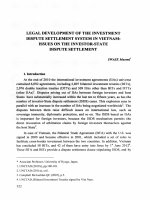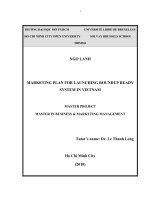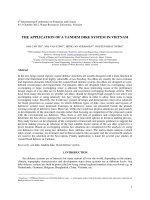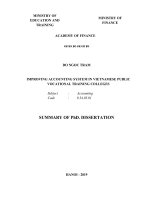National Influenza Surveillance System in Vietnam
Bạn đang xem bản rút gọn của tài liệu. Xem và tải ngay bản đầy đủ của tài liệu tại đây (1.35 MB, 54 trang )
<span class="text_page_counter">Trang 1</span><div class="page_container" data-page="1">
<b>National Influenza Surveillance System in Vietnam (NISS) </b>
<b>Ngo Huy Tu, MD, MPM </b>
<b><small>Epidemiology Department </small></b>
<b><small>National Institute of Hygiene and Epidemiology </small></b>
</div><span class="text_page_counter">Trang 2</span><div class="page_container" data-page="2"><b>Surveillance </b>
<i> Systematic collection, analysis, interpretation </i>
<i>and dissemination of information for use in </i>
<i>public health action </i>
</div><span class="text_page_counter">Trang 3</span><div class="page_container" data-page="3"><b>Why sentinel surveillance? </b>
as an early warning, but:
</div><span class="text_page_counter">Trang 4</span><div class="page_container" data-page="4"><b>What are the goals of the surveillance? </b>
matching?
</div><span class="text_page_counter">Trang 5</span><div class="page_container" data-page="5"><b>Number of ILI cases in Vietnam, 2004 – 2015 </b>
<b><small>(Data from national communicable diseases surveillance system) </small></b>
</div><span class="text_page_counter">Trang 6</span><div class="page_container" data-page="6"><b>Influenza surveillance in Vietnam </b>
surveillance and no laboratory-enhanced active sentinel surveillance
</div><span class="text_page_counter">Trang 7</span><div class="page_container" data-page="7"><b><small>Severe Acute Respiratory Infection (SARI) </small></b>
<b>Influenza-Like Illness (ILI) </b>
<b>Venn diagram of respiratory illnesses </b>
<b><small>Viral </small></b>
<b><small>Influenza </small></b>
<b>Bacterial </b>
</div><span class="text_page_counter">Trang 8</span><div class="page_container" data-page="8"><b>Pyramid of influenza virus infections </b>
<b><small>Asymptomatic </small></b>
<b><small>Mild symptoms, no medical care Mild symptoms, </small></b>
<b><small>outpatient care Severe symptoms, </small></b>
<b><small>inpatient care ICU </small></b>
<b><small>Death </small></b>
<b>Severity </b>
<b><small>Attempted to be detected by: </small></b>
<b><small>Pyramid within pyramid represents (re)emerging influenza virus with </small></b>
<b><small>pandemic potential SARI and SVP </small></b>
<b><small>surveillance </small></b>
<b><small>ILI surveillance </small></b>
<b><small>Household surveys </small></b>
<b><small>Serology studies </small></b>
</div><span class="text_page_counter">Trang 9</span><div class="page_container" data-page="9"><b>Sentinel Influenza surveillance System in Vietnam </b>
<b>General Objective </b>
To collect the necessary epidemiological and virological
information to guide influenza prevention and control policies and activities. Gradually establish the nationwide influenza surveillance network in Vietnam.
</div><span class="text_page_counter">Trang 10</span><div class="page_container" data-page="10">
<b>Specific Objectives </b>
1. Describe epidemiological, virological characteristics and Monitor influenza virus strains circulating in Vietnam. Introduce influenza virus strains for vaccination.
2. To detect avian influenza viruses including emerging strain such as A/H5N1, A/H7N9 and outbreak potential re-assortment of influenza virus genomes and mutation.
3. Gradually establish the nationwide influenza surveillance
network in Vietnam to guide influenza prevention and control policies and activities
4. Contribute in FLunet (Global Influenza Surveillance and Response System) and WHO Collaborating Centers
</div><span class="text_page_counter">Trang 11</span><div class="page_container" data-page="11">
<b>Selecting sites </b>
<small>1. Is geographically representative </small>
<small>2. Has a high density of population, high level of commercial and cultural exchanges </small>
<small>3. Urban and rural coverage </small>
<small>4. Sentinel surveillance is based in health facilities that already have the necessary infrastructure, equipment, and trained staff. </small>
<small>5. Has close collaboration in specimens and data collection </small>
<small>6. Has the ability to preserve specimens at the proper temperature and easy transport specimens to the laboratory </small>
<small>7. Is a commitment and willingness to participate. </small>
<small>8. Ability to long term maintained surveillance activities </small>
<small>For ILI: Admits a large number of ILI patients (at least 50 patients/week) </small>
</div><span class="text_page_counter">Trang 12</span><div class="page_container" data-page="12"><b>ILI Surveillance sites, 2006-2015 </b>
<b><small>16 sites: 7 in the northern; 3 in the central; 1 High plateau; 4 in the southern </small></b>
</div><span class="text_page_counter">Trang 13</span><div class="page_container" data-page="13"><b>ILI Cases Definitions </b>
Influenza-like illness (ILI)
Criteria for sample collection
within 3 days
</div><span class="text_page_counter">Trang 15</span><div class="page_container" data-page="15"><b>ILI TIME IMPLEMENTATION, 2006-2015 </b>
</div><span class="text_page_counter">Trang 16</span><div class="page_container" data-page="16"><b>Selected ILI results (cumulative) </b>
Cumulative results in period 2006 to 2015
</div><span class="text_page_counter">Trang 17</span><div class="page_container" data-page="17"><b>Rate of positive of Influenza A and B by month 2006-2015 </b>
<small>1 3 5 7 9 11 1 3 5 7 9 11 1 3 5 7 9 11 1 3 5 7 9 11 1 3 5 7 9 11 1 3 5 7 9 11 1 3 5 7 9 11 1 3 5 7 9 11 1 3 5 7 9 11 1 3</small>
<small>% dương tính% cúm B% cúm A</small>
</div><span class="text_page_counter">Trang 18</span><div class="page_container" data-page="18"><b>Rate of positive ILI samples by influenza subtype by month 2006-2015 </b>
<small>1 4 7 10 1 4 7 10 1 4 7 10 1 4 7 10 1 4 7 10 1 4 7 10 1 4 7 10 1 4 7 10 1 4 7 10 1 4</small>
<small>KhácA/H1N1pdmA/H3N2BA/H1N1</small>
</div><span class="text_page_counter">Trang 19</span><div class="page_container" data-page="19"><b><small>Rate of positive ILI samples by age group and by year 2006-2015 </small></b>
<small>Total2006200720082009201020112012201320142015</small>
</div><span class="text_page_counter">Trang 20</span><div class="page_container" data-page="20"><b>Distribution of positive samples by gender and virus sub-type, 2013-2015 </b>
<small>50.7 49.3 </small>
<b><small>A/H1N1 </small></b>
<small>53.3 46.7 </small>
<b><small>B </small></b>
<small>51.4 48.6 </small>
<b><small>A/H3N2 </small></b>
<small>51.8 48.2 </small>
<b><small>Tổ g số + </small></b>
<small>50.5 49.5 </small>
<b><small>A/H1N1 pdm </small></b>
</div><span class="text_page_counter">Trang 21</span><div class="page_container" data-page="21">• The Influenza infection rate in men and women almost equally.
• Influenza mainly influence on children under 15.
</div><span class="text_page_counter">Trang 22</span><div class="page_container" data-page="22"><b>Selecting sites </b>
<small>1. Is geographically representative </small>
<small>2. Has a high density of population, high level of commercial and cultural exchanges </small>
<small>3. Urban and rural coverage </small>
<small>4. Sentinel surveillance is based in health facilities that already have the necessary infrastructure, equipment, and trained staff. </small>
<small>5. Has close collaboration in specimens and data collection </small>
<small>6. Has the ability to preserve specimens at the proper temperature and easy transport specimens to the laboratory </small>
<small>7. Is a commitment and willingness to participate. </small>
<small>8. Ability to long term maintained surveillance activities </small>
<small>For ILI: Admits a large number of ILI patients (at least 50 patients/week) </small>
<small>For SARI: Is a centre for diagnosis and treatment of severe acute respiratory diseases </small>
</div><span class="text_page_counter">Trang 23</span><div class="page_container" data-page="23"><b>SARI Surveillance sites (2010 – 2015) </b>
<small>23 </small>
<b><small>BV Bạch Mai </small></b>
</div><span class="text_page_counter">Trang 24</span><div class="page_container" data-page="24"><b>SARI Definitions </b>
Severe Acute Respiratory Infection (SARI)
For children < 5 years:
• Cough or difficult breathing AND • Any one of the following:
<small>– Breathing > 60/min for ages <2m </small>
<small>– Breathing > 50/min for ages 2m to < 1yr – Breathing > 40/min for ages 1 to < 5 years – Chest indrawing </small>
<small>– Stridor in a calm child </small>
<small>– Unable to drink or breast feed – Vomits everything </small>
<small>– Convulsions </small>
<small>– Lethargic or unconscious </small>
<small>– Oxygenation saturation < 90% </small>
</div><span class="text_page_counter">Trang 25</span><div class="page_container" data-page="25"><b>SARI Definitions </b>
Severe Acute Respiratory Infection (SARI)
</div><span class="text_page_counter">Trang 27</span><div class="page_container" data-page="27"><b>SARI SURVEILLANCE RESULTS, 2011-2015 </b>
• Total patients visit: 228.656
• Total SARI: 37.541 (16% in total admissions patients) • Total SARI sample collected for testing: 5.148
• Total SARI sample tested using RT-PCR: 5.148
• Total SARI samples positive with influenza 611 (11,9%)
</div><span class="text_page_counter">Trang 28</span><div class="page_container" data-page="28"><b>PROPORTION SARI/TOTAL ADMISSION AND PROPORTION SARI SAMPLE POSITIVE WITH INFLUENZA ,2011-2015 </b>
<small>28 </small>
<small>0102030405060</small>
</div><span class="text_page_counter">Trang 29</span><div class="page_container" data-page="29"><b>Distribution of SARI patients by region and aetiologies, 2011-2015 </b>
<b><small>Region Total samples No positive </small><sup>A/H1N1/09 </sup></b>
</div><span class="text_page_counter">Trang 30</span><div class="page_container" data-page="30"><b><small>DISTRIBUTION OF POSITIVE RATE WITH FLUENZA BY MONTH AND YEAR 2011-2015 </small></b>
<small>20112012201320142015</small>
</div><span class="text_page_counter">Trang 31</span><div class="page_container" data-page="31"><b>Distribution of influenza viruses by time, 2011-2014 </b>
<b><small>020406080100</small></b>
</div><span class="text_page_counter">Trang 32</span><div class="page_container" data-page="32"><b>DISTRIBUTION OF SARI BY AGE GROUP </b>
<small>20.030.0</small>
</div><span class="text_page_counter">Trang 33</span><div class="page_container" data-page="33"><small>• Proportion of SARI/Total Admission: 16.5% </small>
<small>• Influenza viruses account for 12% SARI patients. There were two picks in March and June. </small>
<small>• Age group 0 – 4 years old account more than 50% SARI patients. </small>
<b>CONCLUSION </b>
</div><span class="text_page_counter">Trang 34</span><div class="page_container" data-page="34"><b>Case definitions for SARI Surveillance 2016 - 2017 </b>
– SARI (using WHO case definition 2014):
</div><span class="text_page_counter">Trang 36</span><div class="page_container" data-page="36"><b>SARI Sentinel sites, 2016-2017 </b>
<b><small>2 Bệnh viện Nhi Trung 3 </small></b>
<b><small>4 5 6 B</small></b>
<b><small>7 Bệnh viện Trung 8 </small></b>
<b><small>9 </small></b>
<b><small>11 12 13 </small></b>
</div><span class="text_page_counter">Trang 37</span><div class="page_container" data-page="37"><small>10 ới Tp HCM </small>
<small>11 </small> <sub> </sub> <sub> </sub> <sub> </sub> <sub> </sub> <sub> </sub> <sub> </sub> <sub> </sub> <sub> </sub> <sub> </sub> <sub> </sub> <sub> </sub>
<small>12 </small> <sub> </sub> <sub> </sub> <sub> </sub> <sub> </sub> <sub> </sub> <sub> </sub> <sub> </sub> <sub> </sub> <sub> </sub> <sub> </sub> <sub> </sub>
<small>13 </small> <sub> </sub> <sub> </sub> <sub> </sub> <sub> </sub> <sub> </sub> <sub> </sub> <sub> </sub> <sub> </sub> <sub> </sub> <sub> </sub> <sub> </sub>
<small> </small> <sup>CDC support </sup><small> </small> <sup>WHO support </sup>
</div><span class="text_page_counter">Trang 38</span><div class="page_container" data-page="38"><b>Distribution of influenza on SARI </b>
<b><small>Region </small><sup>Samples Influenza positive </sup><sup>A/ H1N1/pdm </sup><sup>A/ H3N2 </sup><sup>B </sup></b>
<b><small>Other influenza </small></b>
</div><span class="text_page_counter">Trang 39</span><div class="page_container" data-page="39"><b>Distribution of 7 non influenza viruses on SARI </b>
<b><small>No HMPV Adeno P1 P2 P3 RSV Rhino Co-infection </small></b>
<b><small># # % # % # % # % # % # % # % # % </small></b>
<small>Miền </small>
<small>Bắc </small> <sup>926 </sup> <sup>23 </sup> <i><sup>2.5%</sup></i> <sup>46 </sup> <i><sup>5.0%</sup></i> <sup>32 </sup> <i><sup>3.5%</sup></i> <sup>5 </sup> <i><sup>0.5%</sup></i> <sup>42 </sup> <i><sup>4.5%</sup></i> <sup>127 </sup> <i><sup>13.7%</sup></i> <sup>100 </sup> <i><sup>10.8%</sup></i> <sup>53 </sup> <i><sup>5.7%</sup></i><small>Miền </small>
</div><span class="text_page_counter">Trang 40</span><div class="page_container" data-page="40"><b>SEVERE PNEUMONIA SURVEILLANCE (SVP SURVEILLANCE) </b>
</div><span class="text_page_counter">Trang 42</span><div class="page_container" data-page="42">carbondioxide saturation level)
• Chest X-ray consistent with viral pneumonia
• No suspect diagnoses of other aetiology such as
bacterial pneumonia, tuberculosis etc. were made by specialist conference.
</div><span class="text_page_counter">Trang 43</span><div class="page_container" data-page="43"><small>6/20/2017 43 </small>
Surveillance sites
– Passive surveillance system at all
<b>hospitals in 63 provinces. </b>
</div><span class="text_page_counter">Trang 45</span><div class="page_container" data-page="45"><b>Methods </b>
– Sampled, epidemiological and clinical data collected on form for all SVP cases.
– Data and samples sent to regional lab
– All specimens will be tested in laboratories of 4 regional institutes using RT-PCR
– Standardized Laboratory Management in Lab network
</div><span class="text_page_counter">Trang 48</span><div class="page_container" data-page="48"><b>Distribution of SVP cases by aetiologies, 2006-2015 </b>
<b><small>Lab results 2006 2007 2008 2009 2010 2011 2012 2013 2014 2015 </small><sup>Total </sup><small>(%) </small></b>
</div><span class="text_page_counter">Trang 49</span><div class="page_container" data-page="49"><b>Influenza A(H5N1) virus in Vietnam, 2003-2015 </b>
<small>64 deaths/127 cases in 41 provinces/cities </small>
</div><span class="text_page_counter">Trang 50</span><div class="page_container" data-page="50"><small>• Influenza viruses account for 16.9% SVP patients. </small>
<small>• Early detect avian influenza A/H5N1. in the period 2006-2014 33/34 (97%) avian influenza A/H5N1 cases were detected through SVP surveillance system. </small>
<small>• In Vietnam, not yet found any cases of influenza A(H7N9) in humans. </small>
<b>CONCLUSION </b>
</div><span class="text_page_counter">Trang 51</span><div class="page_container" data-page="51"><b>ACHIEVEMENTS OF NATIONAL INFLUENZA SURVEILLANCE SYSTEM </b>
<small> Establishment of the National Influenza Surveillance System </small>
<small> Provide epidemiological and virological information on all strains of human influenza in Vietnam through active surveillance </small>
<small> Detect outbreaks of Avian Influenza in Human by Passive surveillance for Viral Pneumonia (SVP) </small>
<small> Contribute to national influenza prevention and control, especially Strengthen Public Health Laboratory Networks </small>
<small> Sharing influenza isolates for Vaccine candidates of Northern Hemisphere </small>
<small> Serve as a background and basis for further researches on influenza viruses. </small>
<small> Reporting on weekly basis on the FluNet (Global Influenza Surveillance and Response System) </small>
</div><span class="text_page_counter">Trang 52</span><div class="page_container" data-page="52"><b>ADVANTAGES </b>
Advantage of support from MOH, GDPM, district and
provincial PMC, sentinel hospital, US.CDC representatives Standardized Laboratory Networks, high quality performance
and stability in all 4 regions
Enthusiastic staffs, dynamic, professional and technical mastery
Effectiveness of the system to provide timely information to contribute to guide influenza prevention and control policies and activities.
</div><span class="text_page_counter">Trang 53</span><div class="page_container" data-page="53"><b>CHALLENGES </b>
System depends on outside funding, needs for long term with stable financial source to maintain and further strengthen the system.
At provincial level, laboratory testing to confirm viruses
unavailable, test result is always late to be useful for on time intervention and treatment
High costs of biological testing products, there is no
standardized estimating procedures and SOP for an effective management of biological products.
Settlement and contract’s signatures was made late on scheduled activities.
</div><span class="text_page_counter">Trang 54</span><div class="page_container" data-page="54">








